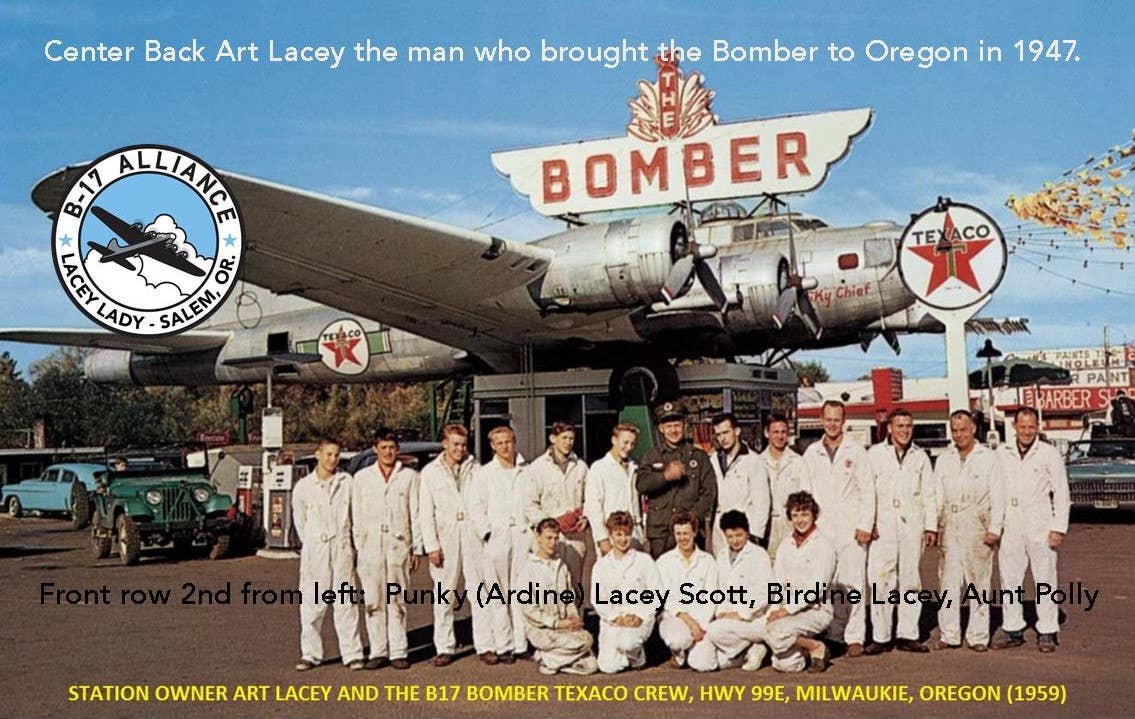Oregon Museum Hosts Fundraiser for ‘Gas Station Bomber’ Restoration
‘Lacey Lady’ was one of the last B-17G produced during World War II and amassed around 50 flight hours.

The crown jewel of the B-17 Alliance Foundation’s collection is ‘Lacey Lady,’ the B-17G that for many decades sat atop a gas station in Milwaukie, Oregon. [Courtesy Terry Scott, B-17 Alliance Foundation]
When it comes to raising money in the aviation world, you can't go wrong with a World War II big band dance. That's what the folks at Salem, Oregon-based nonprofit B-17 Alliance Foundation,are counting on.
The Alliance runs an aviation museum located at Salem McNary Field (KSLE). The crown jewel of the collection is Lacey Lady, the B-17G that for many decades sat atop a gas station in Milwaukie, Oregon. On December 7, the Alliance is holding its annual fundraising gala, "Swing Time Christmas."
The event, which will feature a live swing band, is both a fundraiser and a thank-you for volunteers, according to Terry Scott, executive director of the B-17 Alliance Foundation. Ticket prices begin at $150, and all proceeds go to supporting the aircraft and educational and preservation programs at the museum.
"We plan to restore the aircraft to airworthiness status," Scott said. "Since 2015, over 8,000 volunteer man-hours have gone into the restoration."
End of the Production Line
Scott said that Lacey Lady was one of the last to be produced during WWII.
"This is the lowest-time B-17 left in existence," she said. "It was produced at the end of the war and never saw combat. It has maybe 50 flight hours on it."
The story of Lacey Lady began in 1947, when Oregon resident and entrepreneur Art Lacey—Terry Scott's grandfather-in-law—made a $5 bet with a friend about the acquisition of a B-17. At the time, B-17s were being sold as war surplus. Most were sold for scrap, but a few remained in use as aircraft.
Lacey planned to use the airplane to gain attention for his filling station and later restaurant that was just outside of town. He predicted that after the war, more people would be buying automobiles and going on sightseeing road trips in the U.S. They’d need fuel, food—and something to see.
Lacey purchased the B-17G from the airbase in Altus, Oklahoma, for $15,000, (approximately worth $214,009 today, according to Amortization.org). With the help of a friend who flew the heavy bomber in WWII, Lacey was able to get the aircraft to Troutdale, Oregon, where it was dismantled and trucked to the gas station just outside of Portland.
The aircraft went up on pylons in Highway 99E, becoming the Milwaukie Gas Station Bomber.
"For decades it was one of the largest gas stations (by volume) in the United States," Scott said. "It had 24 double pumps, and it was not uncommon to pump 30,000 gallons a day."
For decades, visitors were allowed to climb into the aircraft to look around—until a boy fell out and got hurt. The aircraft was closed to visitors, but it was still a magnificent sight over the gas pumps. So much so that it became known as "the bomber gas station," showing up in numerous guidebooks and magazine articles about roadside attractions.
According to Scott, it was very much a family business. Lacey's children and grandchildren worked at the gas station. As kids, they washed windshields and provided patrons with Coke floats.
Art Lacey died in 2000, and the family continued to operate the business. During routine cleaning of the aircraft, Lacey's grandson (and Terry Scott's husband) Jayson Scott noticed how much damage the weather, birds, and people who entered the bomber—some illegally—had done to the airframe over the decades it had been on display.
"The interior was pretty much gutted,” Terry Scott said. “Over the years people had been helping themselves to souvenirs from inside the aircraft. They took knobs, switches, you name it.”
The family decided to take the bomber out of the weather and find a way to restore it, perhaps all the way to airworthy status. Of the more than 12,000 B-17s built during WWII, just a handful remain, and very few are airworthy and actively flying.
In 2006, the nonprofit B-17 Alliance was created to facilitate the process. Eight years later, the organization raised enough money to dismantle the aircraft and move it off the pylons and into a hangar.
“It helped that the B-17 was designed to be taken apart and moved by flatbed truck,” Scott said.
The restoration began in 2015, and the Alliance hopes to have it completed by 2035.
It is not easy restoring an 75-plus-year-old-aircraft designed for combat and not for extended use. Among the challenges of such a project is finding parts that can be used as a template for a new part. The days of bins of surplus “new old stock” are long gone, and there is the additional task of ensuring the aircraft is airworthy by modern standards without destroying the authenticity of it.
All the work is done by volunteers, and they need more, Scott said. The Alliance is looking for people with mechanical skills for hands-on work or storytellers in the small museum adjacent to the restoration hangar to act as tour guides. The museum is filled with models, dioramas, and personal artifacts, including uniforms, medals, drawings, letters, photographs, and equipment.
The B-17 Alliance Foundation museum is located next to Hangar C at KSLE and is open Tuesdays, Thursdays and Saturdays.

Sign-up for newsletters & special offers!
Get the latest FLYING stories & special offers delivered directly to your inbox






